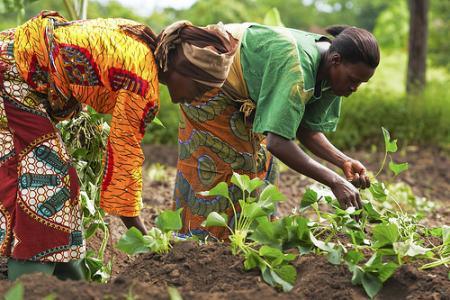
This blog post by Ruth Aine appeared originally on the FARA Africa Agriculture Science Week blog. Picture courtesy CCAFS (Climate Change, Agriculture and Food Security).
The earth’s climate is a’changing
And there are many indicators of that. Temperatures are either going up or dropping in some areas, snow and rainfall patterns all over the world are a mess. I don’t remember when our meteorological department of Uganda predicted steady patterns, for example. We have a lot of unusual torrential rainfall, and plenty of unexpected dry spells. Climate change is being experienced everywhere.As a response to a changing climate and the need to increase food production and sustainability, the CGIAR Research Program on Climate Change, Agriculture and Food Security (CCAFS) has embarked on a participatory action research project: called ‘Climate Smart Villages‘.
The Climate Smart Villages initiative
John Recha is a researcher with CCAFS and he lets us in on his findings. He defines “Climate Smart Villages” as sites where smallholder farmer groups, policy makers, development organizations, extension agents, academic and research institutions work together towards addressing all the risks related to climate change and variability. This partnership is a grand one but also important because it tests a portfolio of interventions (climate smart agricultural activities) that seek to achieve better adapted rural communities, with higher incomes and greater food security.The initiative began one and a half years ago and is at different stages in the CCAFS learning sites in East Africa. The pace at which partners are developing each site is dependent on the local farming system, biophysical environment, policies and institutions.
Benefits
There are a lot of benefits accrued to this project. The farmers that are taking part in this initiative and are affiliated to large community based organizations [CBO’s] have learned and received a lot. They are able to receive capacity building in agronomic services, beekeeping and livestock. In the Nyando CCAFS site in western Kenya, for example, farmer groups that have women have benefited a lot. Their households have gained better incomes, better nutrition and more control over their own food security. Crop productivity has increased while income from selling crops, honey, eggs, and chicken and tree seedlings is helping meet other household needs.Other benefits include being able to reinvest the income generated into some other activities. Horticultural groups, for example, invest some of their proceeds into other high-value traditional vegetables. Within livestock enterprises, the principle of ‘passing on the gift’ enables other community members to acquire the improved breeds.
Interactions within and across groups and CBOs has driven knowledge-sharing and learning. Through the approach, research and development partners and the government Ministries of Agriculture have expanded their extension programmes to meet increased demand.
Scaling up in the region
This initiative provides a model that can be scaled up and replicated in villages within the region. Very important to note as well is that these climate smart villages offer a here fold solution to the region’s food security:Firstly, farmers, researchers, academicians, development partners and extension agents all benefit from uniting around common interests. Participatory processes that involved all stakeholders in identifying and prioritizing interventions have empowered community members to directly request and access information and services.
Secondly, by forming umbrella organizations, farmer groups gain bargaining power and financial resources. The umbrella CBOs have been key in empowering individual groups. As such groups grow, they will become better able to access credit from formal financial institutions such as banks and micro-finance institutions
Thirdly, The Climate Smart Village model takes a ‘gendered approach.’ Thus, community development efforts can contribute to women’s empowerment. Diversification into beekeeping and poultry has particularly helped women; as such enterprises need little land (women face tenure problems in the conservative society of East Africa) and are not labor intensive. Ensuring that leadership roles in farmer groups are open to women is a further path to women’s empowerment. Overall, linking climate risk management, mitigation and adaptation interventions through a broad partnership has diversified enterprises, empowering farmers to become more resilient.
Can youth be a part of this initiative?
According to John Recha, yes they can! Youth associations are a very ideal entry point to reach out to the young people and encourage them that agriculture is not just a sweaty and dirty affair but it also helps one generate income.For example in the Nyando Climate Smart Village, youth groups are particularly involved in horticulture with two outstanding groups growing high value vegetables in greenhouses while practicing drip-irrigation too.
In East Africa, the challenge of land ownership discourages young people from taking up agriculture and the fact that it is labor intensive means they are attracted more to white collar jobs, which are difficult to get. However, youth involvement can be in any part of the agricultural value chain and not necessarily at the farm production level. The youth need to be facilitated to learn practically through farmer learning events like agricultural fairs and exchange visits, and also formal agricultural training. Academic and research institutions are good avenues for mentoring the youth and encouraging them to engage in this innovation.
This is definitely a great initiative that we can encourage our communities to be a part of. We cannot let climate change win, let us fight it!